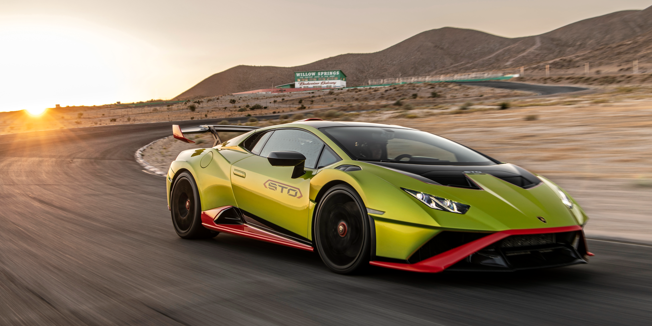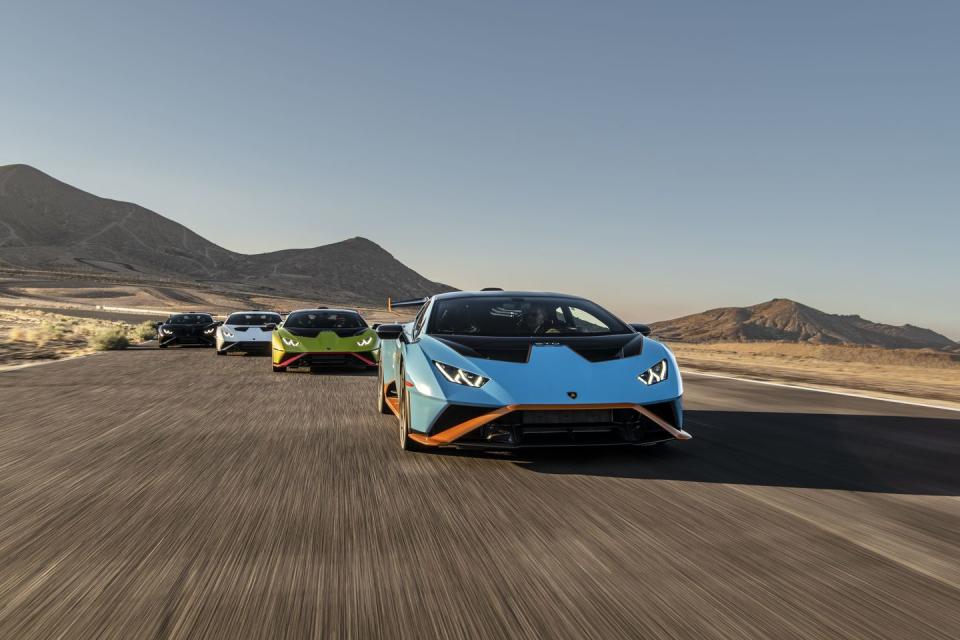Arrivederci, Internal Combustion—Lamborghini Huracán STO Is the Last Fully ICEd Lambo

The Huracán STO is the last, best purely internal-combustion model from Lamborghini.
The STO is a collaboration between Lamborghini’s R&D, Squadra Corse, and Centro Stile departments, and features a normally aspirated V10 with 640 hp and 417 lb-ft of torque.
Lambo models will see hybrids start replacing ICE by 2024, so enjoy it while you can, it’s only $327, 838.
The automotive world is driving itself into electrification, which isn’t necessarily a bad thing—ask anyone who’s driven a Rimac Nevera, Pininfarina Battista, or even a Porsche Taycan Turbo. But while electrification is in the works, it’s not fully here yet. There are still a few very thrilling last hurrahs of pure internal combustion out there.
One of the best is surely the new Lamborghini Huracán STO. The STO is a road-going, fully registerable version of the Raging Bull’s racing supercar, the V10-powered Huracán GT3. The Huracán GT3—built on the same production line as the road-going Huracán—races in at least 12 different series around the world, including the IMSA WeatherTech SportsCar Championship. The car has won races and championships all over the globe for many years now. Last week it took its eighth GT World Challenge America victory and maiden DTM podium. The week before that it took victories in British GT and GT Open to get within title distance there. And the week before that it dominated in the GT World Challenge Europe 3 Hours of Nürburgring. Throw in three wins at Daytona, two at Sebring, and numerous other victories at numerous other tracks all over the globe, and you start to see that the Huracán is a pretty sound platform on which to build a race car.

But would it make a good road car in semi-racing trim? The short answer is, “Yes.” Witness the Huracán Super Trofeo Omologata, or STO to its friends. Lamborghini calls it, “The purest concentration of Squadra Corse’s motorsports prowess, drawn from Lamborghini Huracán Super Trofeo EVO and GT3 EVO racecars, in a street-homologated super sports car.”
The Huracán STO is a collaboration between Lamborghini’s R&D, Squadra Corse, and Centro Stile (styling) departments, “…with every line and every feature aesthetically outstanding while optimized to ensure the best driving performance,” Lamborghini says.
Output of the normally aspirated V10 goes from 602 hp at 8250 rpm in the regular Huracáns to 640 in the STO. Torque rises by 3 lb-ft to 417.
“The engine has been calibrated for a very sporty and responsive racing feel, with a direct pedal-to-throttle feeling and improved engine sound sharpness at high revs,” Lamborghini says.

Likewise, the car’s setup has been sharpened, with a wider track, stiffer suspension bushings, new antiroll bars, and a new version of MagneRide electromagnetic ride control 2.0. The Huracán’s rear-wheel steering has been recalibrated for a racing application. Both ESC and ABS can be adjusted to suit different tracks and different talent levels. ESC can be switched off completely. An all-new exterior design sees new air ducts, front splitter, and louvers up front (the whole front bodywork is a single unit), the hood gets new ducts, there’s a big air scoop on the roof followed by a new longitudinal fin in back, and a new rear fender similar to the one on the Super Trofeo EVO reducing drag. The rear wing can be set to three positions depending on which track you’re running on. And brake cooling ducts keep the new CCM-R brakes four times cooler than stock. The ANIMA (Adaptive Network Intelligent Management) driving adjuster has three new modes: STO, Trofeo, and Pioggia; STO is for street, Trofeo is for the track, and Pioggia is for wet.
“The STO delivers all the emotion of a race car while providing a comfortable road experience,” Lamborghini promised.
Thus informed, they sent me out on the track, though not without adult supervision. The guy I would be following, also driving an Huracán STO, was IndyCar driver, Indy Lights season runner-up, and Italian Formula 3 third-place season finisher Richard Antinucci, who was also none other than Eddie Cheever’s nephew.
So how hard could it be to follow him?
The first problem with this and some other supercars is just fitting into them, especially with a helmet. You really can’t. I’m only a tad over six feet tall and while I do have a freakishly long, fish-like torso, there was no way I was going to keep my head vertical. Antinucci said to slide the seat bottom cushion forward, which would allow the seat back to recline a little, but my helmet was still whanging against the carbon fiber roof. What the heck, how often would I have this opportunity again? I set the ANIMA to Trofeo, tugged the seat belt as tight as possible to keep as many internal organs as I might need in later life, and roared off behind my Italian guide.
I know Big Willow more than any track, but still sometimes forget that they widened the whole thing about 15 years ago. Thus, my brain takes a lap or two to fully believe that and get up to speed. Here are my notes:
“I haven’t been this terrified since driving the Senna at Estoril. Crammed inside a carbon fiber can (actually, it’s an aluminum and carbon fiber can), carcass reclined at maximum angle to fit a space made for short, dashing Italians, my helmeted head whackity whack-whacking against the carbon fiber roof, trying to hold onto the expensive suede-wrapped steering wheel and not scream because screaming shows up on the telemetry, I drove.”
Antinucci was going pretty fast, though I could tell where he was politely slowing down for me. He took different lines through Turn 4 and through 8 and 9. “I am a diamond driver,” he said later, meaning he went out to a point, took a sharp turn then went to the next point. He added an inside apex between 8 and 9, for instance, which may have been faster than the stay-outside-the-whole-way method I had been taught my whole life.
The car held on and never really got squirrely. Almost never, but when it did, the ESC and all the other acronyms took over.
One thing you notice at ridiculous speeds is how bumpy just about any surface except maybe a pool table is. I was going into Turn 8 at 125 mph and was over 150 when I lifted at the end of the front straight. Best I got was a 1:33. At those speeds, like I said, little imperfections become big, Trophy Truck desert whoop-dee-doos.

But the brakes were superb, the steering never faltered, and the Trofeo driving mode meant I only slid around a little here and there, mostly exiting the uphill section above Turn 3 and maybe in 4. Was this a great track car? Si, prego. Would I want one? If I had a racetrack, or if I had a full ride in some kind of Squadra Corse racing series, also si. Otherwise I would look at the 720S or F8 Tributo, too.
Back in the pits, I suggested to Lamborghini’s chief engineer Maurizio Reggiani, who I have known for many years, that the car would be faster with softer springs. The entire room full of Italians, whom I have not known for years, gasped, like that scene in Oliver when the kid asks for more gruel. Reggiani laughed. The springs remained as they are. What do I know about race engineering?
I enjoyed it, as you should be out enjoying the end of the internal combustion epoch. Lamborghini has said it will reduce emissions by 50 percent starting from 2025 onward. Last month’s Quail A Motorsports Gathering saw the introduction of a new Countach, a super-refitted Aventador that used supercapacitors as a hybrid drivetrain. The next Aventador will get a V12 gasoline engine mated to an electric motor and a nice battery pack. The next Urus could share a hybrid drive system with the Porsche Cayenne Turbo S E-Hybrid. The next Huracán could get a twin-turbo V8 with one or two electric motors driving the front axles and a hybrid-assist boosting the rears. And Lamborghini has said that a pure EV will be coming after all that. A bettin’ man would note the cooperative agreement with Rimac and Porsche and guess it might be something from there, but who knows?
The point is, the days of straight-up outrageous V12 and V10 supercars are numbered, so start counting, and driving, now.

